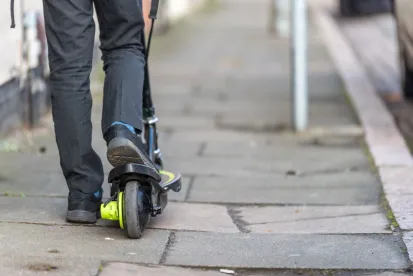Electric scooters and the shared economy
If you have spent any time in Los Angeles or New York City recently, you may have noticed adults riding two-wheeled electric scooters − the type we are more accustomed to seeing kids ride. These scooters are the latest transportation tools in the ever-evolving sharing economy.
The sharing economy, a term used to describe the growth of an economy based on sharing goods and services, just witnessed the newest heavyweight enter the ring – motorized electric scooter companies. All you have to do is download an app on your smartphone, enter your credit card information, find an electric scooter using the app, and scan a barcode. Typically, rental scooters cost $1 to start and 15 cents a minute thereafter. When you reach your destination, simply leave the scooter in a public space and tap your screen to end the ride.
The scooters can reach speeds of up to 15 miles per hour, and there are almost no regulations in place to ensure their safe use. Additionally, it is not always clear whether the scooters should be driven on sidewalks, in bike lanes, or on roadways. In fact, some cities do not require riders to wear helmets. Finally, few riders are clear on whether they are subject to traffic laws (they are in most, if not all, cities).
Recently, scooter-sharing companies have drawn the ire of plaintiffs’ lawyers across the country. Both riders and pedestrians injured on or by scooters are making waves in courthouses and the media, calling for increased regulation or, in some cases, prohibition of the scooters altogether. Complaints have been filed against scooter-sharing companies based on allegations of gross negligence, aiding and abetting assault, and creating a public nuisance. These companies are not alone, however, in facing potential liability for injured riders and pedestrians. Scooter manufacturers also have been named for any number of alleged defects with the scooters.
Scooter and parts defects
Scooter manufacturers may soon face a number of product defect claims. While not an exhaustive list, these claims could include the following:
-
Failed brakes – At 15 miles per hour, functioning brakes are essential to riders and pedestrians. And, the 15 mile-per-hour maximum speed does not account for scooters going downhill. The scooters can reach even higher speeds and, consequently, create a higher risk of serious injury or death.
-
Stuck throttles – Likewise, riders and pedestrians face an increased risk of injury when throttles get stuck, making the rider unable to slow down.
-
Exploding batteries
-
Flat tires
-
Inoperative lights
-
Broken tubes – If the tubes that transmit power within the vehicle suddenly break, riders risk being thrown off.
-
Defective handlebars
-
Failure to warn of hidden dangers associated with the use of this unique electric vehicle.
The potential of such claims should be enough to capture the attention of astute product liability insurers.
Why electric scooters?
An array of products are used as part of the sharing economy – cars, houses, bicycles, cameras, kitchenware, musical instruments, boats, construction equipment, outdoor gear, and more. So why should insurance companies pay particularly close attention to scooters?
The answer is because the popularity of electric scooters is growing at an unprecedented pace. Adoption rates in metro areas across the United States are accelerating faster than other players in the ride-sharing economy (i.e., cars). In addition to the incredible adoption rates, public support is high among people from anywhere on the socioeconomic spectrum, with the greatest support from low-income groups, presumably because scooters require much fewer infrastructure investments. And, scooter-sharing companies are not going away. On the contrary, major scooter-sharing companies such as Bird and Lime have begun expanding internationally. So, what should risk advisors expect with regard to claims and lawsuits?
What to expect
The leading electric scooter company, Bird Rides, Inc.’s robust liability waiver has so far limited the number of cases plaintiffs’ lawyers are willing to take. The waiver provides that all riders, in exchange for the use of “Bird Services, [v]ehicles, and other equipment… [,] agree[ ] to fully release, indemnify, and hold harmless Bird…from liability for all ‘Claims’ arising out of or in any way related to … use of the Bird Services, [v]ehicles, or related equipment…[,] except for [c]laims based on … gross negligence or willful misconduct.” Nonetheless, the class-action lawsuit filed in Los Angeles County Superior Court on October 19, 2018 – case number 18-STCV-01416 – has garnered enough attention from the public and media that an influx of claims should be expected.
The Los Angeles County lawsuit names, in addition to Bird, leading competitor Lime (formerly LimeBike), and manufacturers Xiaomi USA, Inc. and Segway, Inc. The plaintiffs’ claims include Strict Products Liability, Negligence, Negligence Per Se, Gross Negligence, Breach of Implied Warranty of Fitness for a Particular and/or Intended Purpose, and Breach of Implied Warranty of Merchantability. The blanket of negligence theories cast against the manufacturers is broad. They allege manufacturing defects, design defects, and a charge of inadequate user warnings. It is to be determined how much protection, if any, manufacturers will receive under Bird’s liability waiver. It is very likely, though, that the plaintiffs will be allowed to pursue lawsuits under a theory of, at least, gross negligence.
Another big question is whether and how many of these suits will get to a jury. The comprehensive waiver in Bird’s user agreement includes an administrative dispute resolution process, followed by a binding arbitration provision in the event the parties are unable to settle a claim. It also includes a class action waiver. However, the opt-out provision in the same section of the agreement provides: “You have the right to opt-out and not be bound by the arbitration and class action waiver provisions … by sending written notice of your decision to opt-out to the [Bird] address…. The notice must be sent within 30 days of the effective date or your first use of the Service, whichever is later….”
Whether claims are brought in court or moved into arbitration, a rigorous defense is called for on behalf of the manufacturers. Because scooters are often left at the scene of an incident wherein injuries were suffered, there may be no physical evidence of a defect in the scooter and/or parts. Even if there were some malfunction, mechanical or otherwise, plaintiffs must prove that any injuries were the direct and proximate result of the scooter, rather than user error. These factual hurdles also have served to limit the number of lawsuits brought thus far.
There is an array of issues, legal and factual, that must be scrutinized upon receiving notice of a claim or suit. And, it is not simply the electric scooter companies that need to brace for an influx of claims – scooter and parts manufacturers are being sued right along with them.



 />i
/>i
